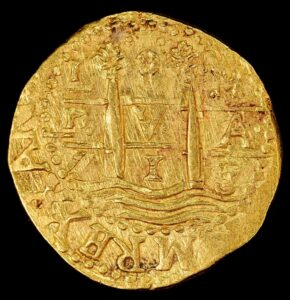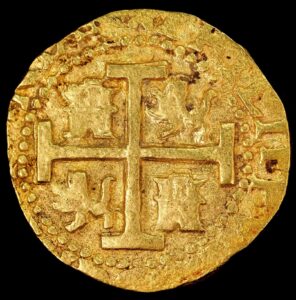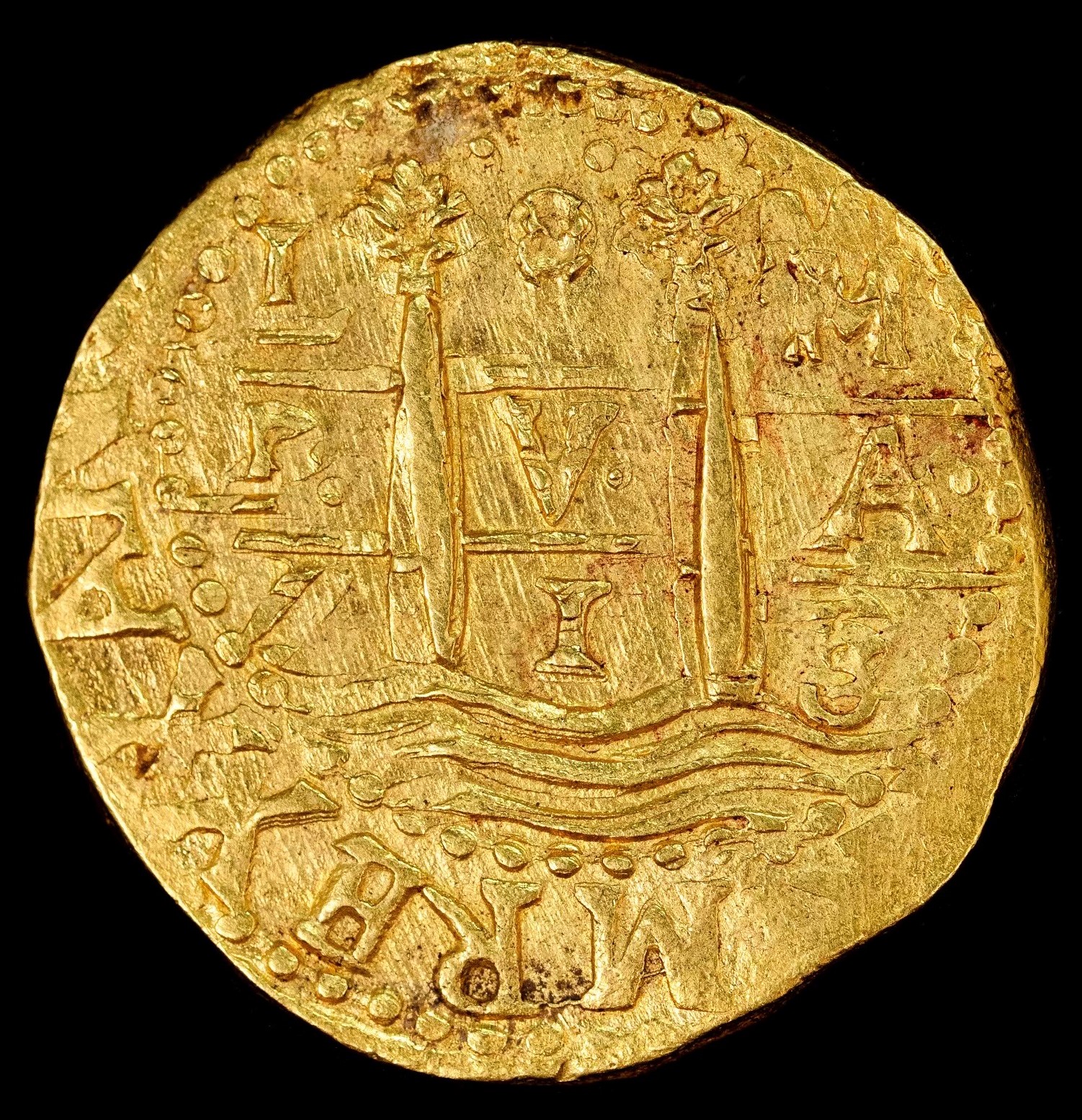During the Spanish conquest of the New World, rich deposits of gold were found throughout Mexico, Peru, Columbia, and other regions. Prior to the gold being shipped back to Spain, it was sent to regional mints where it was melted and refined. These mints primarily converted the gold into 22 karat ingots or coins known as “escudos” or “escudos de oro”, which is Spanish for shields or shields of gold. This name may be in reference to the Habsburg shield that is typically displayed on most Spanish and Spanish colonial coinage from the period, such as this 1 escudo minted in Seville.
Each regional mint had its own unique design for the coins they produced and although hundreds of thousands of escudos were minted from the 16th through the 18th centuries, precious few have survived. Most of the New World escudos either made the journey back to Spain where they were melted down and converted into traditional Spanish coinage or ended up on the bottom of the ocean as a result of hurricanes, accidents, or naval battles.
The Ever-Elusive Lima Eight Escudos
Most examples of New World Spanish gold escudos known today have been recovered from shipwrecks such as the fleet of 11 ships that sunk off the East Coast of Florida in 1715. Of the gold found on these wrecks in the 60’s and 80’s, the majority were the smaller denominations of 1 or 2 escudos. Most of the larger and much rarer 4 or 8 escudos have either been tucked away by the State of Florida or put in pendants as jewelry, which makes collector grade coins even harder to find.
One of the most sought-after coins from the Spanish Colonial period are the ever-elusive 8 Escudos minted in Lima, Peru known as “onzas”, doubloons, or “Lima 8’s”. These magnificent gold cobs weigh in at just under an ounce of gold and are considered by many to be the epitome of pirate treasure. For the advanced collector, finding a Lima 8 in decent condition is hard enough. But to find one that is original, unaltered, and in mint state condition, is like finding a needle in a haystack.
A Unique and Beautiful Design
 The design of the Lima 8 Escudos is unique from all other escudos minted in the Spanish Colonies. To better illustrate this, I will use one of the finest 1713 Lima 8 Escudos ever graded, a 1713 over 1712 graded by NGC as MS-62. Unlike milled coins or modern era coinage, no two silver or gold cobs are exactly the same as these types of coins were struck by hand with a hammer and dies. Oftentimes, as is noticeable on this example, the coins are struck more than once which accounts for the “doubling” effect, which misaligns some of the design elements on the die onto the coin surface.
The design of the Lima 8 Escudos is unique from all other escudos minted in the Spanish Colonies. To better illustrate this, I will use one of the finest 1713 Lima 8 Escudos ever graded, a 1713 over 1712 graded by NGC as MS-62. Unlike milled coins or modern era coinage, no two silver or gold cobs are exactly the same as these types of coins were struck by hand with a hammer and dies. Oftentimes, as is noticeable on this example, the coins are struck more than once which accounts for the “doubling” effect, which misaligns some of the design elements on the die onto the coin surface.
The pillar side of this coin displays the pillars of Hercules rising from the waves with chapiters atop each. The letters and number in the center portion of this 1713 specimen shows (L -8- M over P.V.A.), which represents the following: The “L” is for the Lima mint, the 8 is for the denomination of 8 escudos, “M” is for the mint assayer “Cristobal Cano Melgarejo” and “P-V-A” is a Latin abbreviation for “PLVS ULTRA”, which being translated into English means “Further Beyond”. Plus Ultra is the royal motto of Spain to this day. The legend around the outer perimeter reads “ET YNDIARVM REX ANO 713”, which being translated in English means: “And of the Indies King Year 1713”.
During the time this coin was minted, the New World was commonly known to the Spanish as “The Indies.”
Typically, these doubloons were minted with dies that displayed a very clear date, however in 1713 some were struck with a re-engraved 1712 die where the “2” was changed to a “3” for the new year.
On this specimen, if you look closely, you will see a number 3 struck over the remnants of a number 2. This coin also displays an abundance of vertical die lines as well as a few dark spots which are coral encrustations, proof that this coin sat on the bottom of the ocean for over 300 years.
The Cross, Castles, and Lions
 The design of the cross-side of a Lima 8 Escudos displays a Jerusalem cross at the center, which is a symbol of the union of church and state. At the four quadrants of the cross you see two lions and two castles , which is symbolic of the union between the medieval kingdoms of Castile and Leon. Surrounding the cross, castles and lions is a halo of dots that acts as a border for the legend to sit atop of.
The design of the cross-side of a Lima 8 Escudos displays a Jerusalem cross at the center, which is a symbol of the union of church and state. At the four quadrants of the cross you see two lions and two castles , which is symbolic of the union between the medieval kingdoms of Castile and Leon. Surrounding the cross, castles and lions is a halo of dots that acts as a border for the legend to sit atop of.
Although the legend on the cross side of this coin is not completely visible, the legend should read: “PHILIPPVS V D. G. HISPANIA”, which is an abbreviation in Latin for “PHILIPPVS V DEI GRATIA HISPANIA”. The translation in English means “Philip V by the grace of God of the lands of Spain”.
The varying styles of the lions and castles, die varieties, and strikes all add to the uniqueness of each piece which serves to further enhance the collectability of these amazing coins.
The Rarity of the 1713/12 Lima 8
 According to Phil Flemming of Goldcobs.com “The 1713 Lima onza is a rare Fleet date, “rarissima” in Calico’s judgment. By conservative estimate, it is at least 10 times rarer than the popular 1712 onza that precedes it and rarer than any of the 1707-1711 issues. Prior to 1988, the 1713 Lima was in fact virtually uncollectible. Only four examples were recovered from Douglas Beach (Nieves site) in 1964, one of then immediately impounded into the Florida State Collection. No 1713 Lima onzas were found on Fleet sites in the 24 seasons following 1964. Then in the summer of 1988 salvors got lucky. A total of sixteen Lima 1713’s were reportedly found. That was the good news, the bad news was the condition of the coins. All but three of the 1713 were found imbedded in a gritty, grey conglomerate. When removed from the conglomerate, all showed corrosion, often heavy, staining, and even blistering in some cases. They were certainly among the worst looking onzas recovered from the Fleet. In June of 2003 nine of these 1713’s appeared in a Treasury auction. Collectors were appropriately unimpressed by their condition. Only two onzas (lots 61 and 62) did not display rough, grainy, stained surfaces.” Source: https://www.goldcobs.com/Lima1713.html
According to Phil Flemming of Goldcobs.com “The 1713 Lima onza is a rare Fleet date, “rarissima” in Calico’s judgment. By conservative estimate, it is at least 10 times rarer than the popular 1712 onza that precedes it and rarer than any of the 1707-1711 issues. Prior to 1988, the 1713 Lima was in fact virtually uncollectible. Only four examples were recovered from Douglas Beach (Nieves site) in 1964, one of then immediately impounded into the Florida State Collection. No 1713 Lima onzas were found on Fleet sites in the 24 seasons following 1964. Then in the summer of 1988 salvors got lucky. A total of sixteen Lima 1713’s were reportedly found. That was the good news, the bad news was the condition of the coins. All but three of the 1713 were found imbedded in a gritty, grey conglomerate. When removed from the conglomerate, all showed corrosion, often heavy, staining, and even blistering in some cases. They were certainly among the worst looking onzas recovered from the Fleet. In June of 2003 nine of these 1713’s appeared in a Treasury auction. Collectors were appropriately unimpressed by their condition. Only two onzas (lots 61 and 62) did not display rough, grainy, stained surfaces.” Source: https://www.goldcobs.com/Lima1713.html
Here are some details that make this particular specimen unique and quite special:
1) The overall eye appeal and original mint luster is highly unusual and premium quality for the grade.
2) The original die striations are bold across the fields on the pillar side, which is unusual
3) The overdate is crisp and clear
4) The mint mark, assayer, and P.V.A are crisp and clear on the pillar side
5) The tail of the “7” is visible on the second date at the outer rim
6) The words “RVM REX ANO” are legible on the pillar side
7) On the cross side, the cross, castles and lions are very well centered and the cross is not broken
8) The word “PHILIPPVS” for King Philip V is legible on the cross side
9) On the cross side, the halo of dots around the cross, castles, and lions is unbroken and complete
10) There is an abundance of coral encrustations on both sides of the coin, which indicate that the coin was recovered from a warm water shipwreck
With an abundance of original mint luster, coral encrustations, and amazing eye appeal, this 1713/12 Lima 8 Escudos is an incredible piece of history and simply breathtaking!
For more information on Spanish gold cobs, please contact us at sean@commodorecoins.com.
For more information on Lima 8 escudos and gold cobs from the 1715 fleet, visit: https://1715fleetsociety.com/
Written by Sean Scott


Leave a Reply